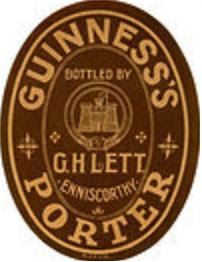"Dublin porter for town trade
This is exampled in the case of Dublin porter, brewed for town trade. With such a beer, of no great stability, and which would not be consumed if flat, it is necessary to force on a cask fermentation to lead to immediate condition; and this is done by merely racking the beer in rooms kept moderately warm by steam pipes, the induced rise of temperature being quite sufficient to set in motion further fermentation, so long as the cask is tightly shived up. At one time there was a dispute as to whether it was advisable to regulate condition in cask or to allow cask fermentation full swing, the upholders of the latter idea asserting that under the great internal cask pressure the secondary fermentation was much more healthy, and was put an end to by pressure itself. I believe that there is a great deal of merit in such a notion, and if the stock beer existed in the cellar from which it was to be drawn, there is no doubt but that the beer fermented under such high-pressure conditions would be remarkably good if it could be tapped and consumed without any disturbance of the bottom deposit."
"The Theory and Practice of Modern Brewing" by Frank Faulkner, 1888, page 252.
That sounds very much like the highly-conditioned casks used in the two-cask serving system, which Guinness used or their Porter right up until it was discontinued in the early 1970s. It's interesting to learn exactly how they got the casks into that condition. Simply by racking the beer in a warm room.
This is what I'm talking about:
Faulkner wasn't impressed by this process. Asserting that the beer would only remain bright while the pressure was maintained. Something which wasn't possible when the beer was served and the cask partially emptied.
"As a practical question, the process is a faulty or impossible one; however bright the beer might be the extreme pressure would lead to immediate turbidity directly it was reduced, by diminishing quantity of fluid contents; while if the beer be stored for lengthy periods, the high pressure gradually disappears, much of the gas causing it passing through the pores of the wood, while the remainder is taken into solution, and when the cask is shipped away it is by no means full, and the contents exhibit but slight capacity of again becoming brisk, the violent fermentation that originally led to the pressure ending in excessive reduction of fermentable character, the high pressure very seriously influencing the vital power of the alcoholic cells present.
"The Theory and Practice of Modern Brewing" by Frank Faulkner, 1888, pages 252-253.
Not so sure that I understand the second half of that paragraph.

Great video Ron. If they stopped brewing porter in 73, but obviously continued brewing stout, what were the differences between the two?
ReplyDeleteNot much difference at all apart from recipe but that is just a hunch.
DeleteOscar
Hi Ron,
ReplyDeletefrom how I read it it sounds as if he's stating that after losing condition over time, it is not possible to get it back because even if fermentable sugars remain because the process was stopped due to pressure, the yeast (the 'alcoholic cells') are too damaged by the pressure to restart the work properly.
So basically once the pressure is gone you have to take the cask as is and cannot get it into perfect condition again.
Apparently Guinness still had different stouts until the 1960’s one of them was Dublin city only.
ReplyDeleteOscar
Anonymous,
ReplyDeletePorter was weaker that Stout: 1036 to 1042.
Were they the same or similar recipes, just with different gravities?
ReplyDeleteAnonymous,
ReplyDeletenot having seen the brewing records, I don't know how similar the recipes were.